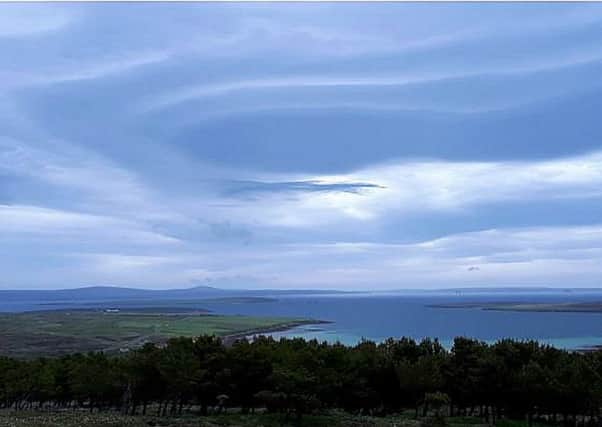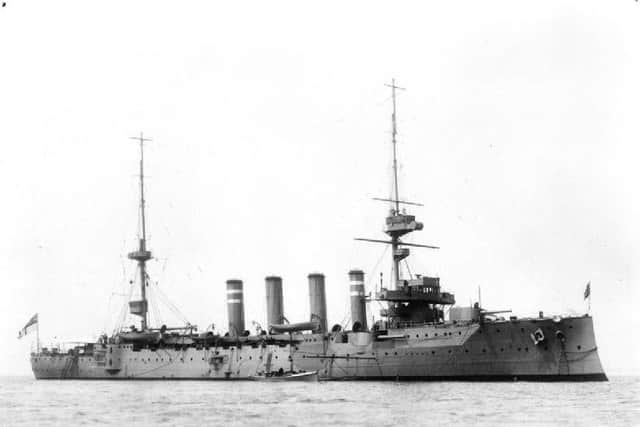Major WWI shipwreck survey off Orkney gets underway


A team from Orkney Research Centre for Archaeology has brought together expertise in diving, marine heritage and underwater electronics to build up the most detailed available picture of the remains.
As a result, 3D models of what lies on the seabed will be created.
Advertisement
Hide AdAdvertisement
Hide AdThe war graves of HMS Hampshire, HMS Vanguard and HMS Royal Oak, which were sunk with the combined loss of almost 2,500 men, are a key focus of the survey.


They will be examined along with the remains of three battleships and four light cruisers from the German High Seas Fleet which remain in the water off Scapa Flow.
A total of 52 German vessels were scuttled by their own forces at the end of World War I but most have already been recovered.


The survey is using a suite of geophysical equipment, Remotely Operated Underwater Vehicles (ROV) and diver survey to collect data that will accurately record the wrecks.
A series of 3D visualisations will then be created by experts at Dundee University to boost understanding of the remains.
University of Highlands and Islands, SULA Diving, Heriot-Watt University, Marine Scotland, Ulster University and technology firm Seatronics are also involved.
Paul Sharman, ORCA Senior Projects Manager, added that, “We are proud and feel privileged to be involved with this important project.
Advertisement
Hide AdAdvertisement
Hide Ad“We are pleased to be working corroboratively with such a wide range of specialists to provide high quality data which will contribute to the understanding of these important marine archaeology sites and commemorate the sacrifice made by the personnel who were on board HMS Vanguard, HMS Hampshire and HMS Royal Oak.”
The findings will contribute to the centenary commemorations of the scuttling of the German High Seas Fleet in 2019.
Andrew Fulton, Historic Environment Scotland, said: “We are pleased to see this next stage of survey
work on the underwater wartime remains of Scapa Flow. The results will help update existing records of the wrecks, guide their management and contribute to the commemoration of
momentous events in wartime history.”
Last year, the redesigned memorial to Lord Kitchener, the former Secretary of State for War who was killed when HMS Hampshire was struck by a mine, was unveiled. It now includes the names of the 736 other men who lost their lives.
HMS Hampshire was an armoured cruiser that was assigned to transport Field Marshal Lord
Kitchener, to Archangel in northern Russia for a meeting with Tsar Nicholas II. During this
Advertisement
Hide AdAdvertisement
Hide Adassignment, the ship struck a mine, off Marwick Head, on the west coast of Orkney. She sank in
twenty minutes with a loss of 737 men including Lord Kitchener
HMS Royal Oak was a revenge class Battleship. The Royal Oak under command of Captain
Commander W.H. Benn sat at anchor when struck by torpedoes fired from U47 under the command
of Kapitanleutnant Günther Prien resulting in the loss of 833 lives.
HMS Vanguard was a St. Vincent class dreadnought battleship destroyed at her mooring by a series
of explosions before midnight on Monday, 9 July 1917. 843 men were lost out of the 845 people on
Advertisement
Hide AdAdvertisement
Hide Adboard. University of the Highlands and Islands, Archaeology Institute, Orkney College KW15 1LX
t +44(0)1856 569 000 e [email protected] w www.uhi.ac.uk/archaeology
The archival research and archaeological remote evaluation surveys that comprise this project will
lead to a full understanding of the condition of the wreck sites, contribute to enhanced heritage
displays, provide data for academic research and support activities and material for public
engagement.
Alistair Coutts, Business Development Manager, Seatronics, said “We are delighted to be
collaborating again with ORCA & UHI and we look forward to working with the collected specialists
Advertisement
Hide AdAdvertisement
Hide Adon this exciting project. Our aim is to use our Predator inspection class ROV and integrated cameras
with 3D modelling technology to provide accurate models and detailed video footage of the current
condition of the wreck sites.
Notes for Editors
• The project lead is Orkney Research Centre for Archaeology (ORCA), University of the
Highlands and Islands Archaeology Institute.
• Marine Scotland vessel MV Scotia will be the work platform for data collection. Data
collection will involve Marine Scotland undertaking MBES survey, providing calibrated
unprocessed raw data and camera equipment for the acquisition of data.
• Seatronics - an Acteon Company will provide ROV, positioning and 3D modelling and
Advertisement
Hide AdAdvertisement
Hide Adspatially cross referenced video inspection equipment photogrammetric equipment.
• Historic Environment Scotland will provide guidance on marine historic assets, survey targets
and specialist knowledge on the wreck sites.
• Ulster University will provide input into the specifications for data acquisition for the
geophysical and ROV surveys and provide input into maritime archaeological assessment
and analysis.
• Heriot-Watt University will provide input into the specifications for data acquisition for the
ROV survey and undertake marine biological studies on the submerged cultural heritage
assets.
• Ministry of Defence will provide input into the specifications for data acquisition for the
geophysical and ROV surveys, and specialist knowledge on the wreck sites being investigated
and environmental studies of the wreck sites
